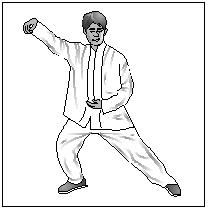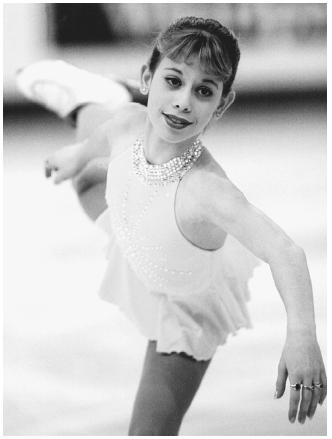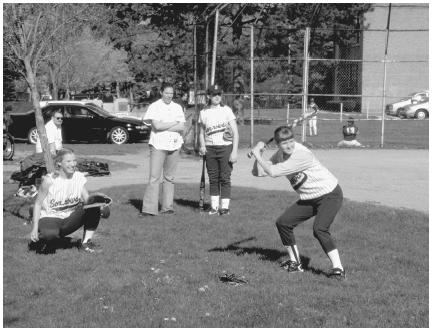Physical Fitness - Activities that promote fitness
There are many types of activities that improve a person's physical fitness. The options range from traditional aerobics to alternative practices such as yoga and martial arts. Each activity has its own specific benefits and requires different kinds of equipment. Choosing the best activities involves finding the ones that are the most pleasurable and fun. The most important thing is doing some kind of activity on a regular basis.
SPORTS AND THE MIND
Participation in sports—and other extracurricular activities such as band or dance troupes—is a great way of staying active, and sports offer wonderful rewards for mental health. Being involved in sports has been proven to help people learn valuable skills for dealing with life's ups and downs. They teach people how to interact with others and work as a team. This helps in daily life when working on a class project or a school play with others. Sports also help people become more independent and feel better about themselves. The result is positive self-esteem and self-confidence, which are extremely important to a person's happiness and success.
Sports also offer a fun and exciting environment in which to learn how to handle both failure and success. Everyone wins and loses at times in both sports and life. Winning feels great and empowering but can also cause a person to feel pressure and anxiety in the next attempt to win. Losing usually produces feelings of sadness, depression, and disappointment. Learning how to cope with these different feelings is important for good mental health.
Another aspect of sports that contributes to a healthy mind is goal-setting. People who have goals are more likely to be self-motivated and are usually able to accomplish more because they know what they need to do in order to get ahead. Without goals, people tend to lack direction and focus. In sports, goal-setting is essential for improving individually and working as a team. This is also true in life. For example, if a person wants to get better grades, accomplishing specific goals—such as studying for a certain period of time each night—is the fastest way to get those As.
Aerobic Exercise
Aerobic exercise strengthens the heart and lungs and tones the body. There are two types of aerobics: high-impact and low-impact. Both involve moving the body for at least twenty minutes in order to increase the heart rate to a point where the body is burning fat. High-impact aerobics involves dance combinations and jumping movements, while low-impact aerobics uses similar movements without the jumping. Low-impact aerobics is gentler to the joints because one foot is always touching the floor and therefore it is less likely to cause injury.
It's possible to get into aerobics through a class at a gym or recreation center as well as at home with a fitness video. Doing aerobics requires good sneakers for support and cool, comfortable clothing.
Biking
Biking is another fun activity that builds strength and balance. Riding for twenty minutes will make the heart strong and help the body burn fat. Most people learn to ride bikes as children, so all it takes to participate is a bicycle and road to ride it on. Some people choose to ride on the road, while others buy a mountain bike that allows them to ride on dirt roads and trails in the woods or in the mountains. In addition to having a bike, people need to wear helmets and have reflectors attached to the bike. Many people ride with friends or even join a cycling club to meet others who like to use their pedals to get their hearts pumping.
Boxing
Boxing tones and strengthens the whole body. Whether a person is just punching the air, called shadow boxing, or punching a bag, boxing helps burn fat, relieve stress, and increase endurance and confidence. People interested in boxing usually take classes at a local gym or learn boxing moves from a video. With boxing gloves and loose, comfortable workout clothing, boxing can be done at a gym, a recreation center, or at home. It's also possible to learn how to kick box, which uses the legs and the arms to punch the air or a bag.
Dance
Dance is great exercise for the whole body. It not only tones the body and burns fat, but it also improves balance and coordination. There are many different types of dance, including ballet, tap, modern, country-western, jazz, and hip-hop. Some people choose to take classes to learn the right technique. This can be especially important for tap and ballet. Others may rent or buy a video that teaches them the right moves. However, dance doesn't have to be structured. Dancing to a song on the radio or to a favorite CD is enough for some people. Dancing in any form is a fun way to become physically fit.
Dance classes are usually available at a private dance studio, a local community center, YMCA, or YWCA. It's necessary to have the proper shoes and sometimes the right clothing to take certain classes.
Gymnastics
Gymnastics is an intense activity that strengthens every muscle in the body. It also improves coordination and flexibility; however, it can be risky since many of the moves include flips and jumps that can cause injury. Practicing gymnastics requires classes at a gym with special equipment, a training camp, or a gymnastics clinic. It also requires an instructor, as gymnastic moves are difficult and cannot be learned without proper instruction. With the right clothing and a coach, a person can become involved with gymnastics for fitness. There is also rhythmic gymnastics, which combines dance and gymnastics and is generally less physically intense than traditional gymnastics.
KIDS AND EXERCISE
Physical activity and exercise are not the same. And while both are good for all people, most experts recommend that kids and preteens focus more on being physically active (such as playing or bike-riding) than on actually doing structured exercise (such as an aerobic exercise class). For example, the American Academy of Pediatrics recommends that weight training not be undertaken until after puberty and bone growth are complete.
Hiking
Hiking gives the legs and heart a good workout. Going up and down hills will strengthen the muscles in the thighs. Continuous hiking will increase the heart rate and burn fat. One of the best things about hiking is being surrounded by

nature. Hiking trails can be found near beautiful mountains, giving hikers many choices of trails that differ in difficulty and scenery. Finding a place to hike, however, is not so easy for those who live in urban and suburban areas. Contacting the local parks and recreation department is the best way to find the closest hiking areas. Hikers need certain things to have a fun and safe time, including a good pair of hiking boots, socks, hat, water, sunscreen, food for energy, a few friends with whom to hike, and a trail map.
Ice Skating
On a frozen pond or in a rink, ice skating works the lower body, including thighs, hips, and buttocks. It also strengthens the heart, burns fat, and improves balance and coordination. Ice skating can be done without instruction, but in order to improve one's skating skills, lessons are a good idea. Individual and group lessons are available at local rinks. It's also possible to learn how to figure skate, which involves doing spins, jumps, and dance moves on the ice. Having a supportive pair of skates is essential. If there's nowhere to ice skate, but the activity is appealing, in-line skating is a great alternative.
In-Line Skating
In-line skating is similar to ice-skating but it's done on concrete, not ice. It works the lower body and strengthens the heart. In-line skating has grown in popularity over recent years and many people consider it to be one of the most fun activities to do. It can be done alone or with friends, and lessons are available at local parks or places where in-line skates are rented. Lessons can help people achieve more complicated moves and jumps. Getting involved means buying or renting a pair of skates, as well as wrist guards, elbow guards, kneepads, and a helmet for protection against falls and collisions.
The Martial Arts
The martial arts are a combination of physical activity and mental strength and development. The practice of the arts goes back thousands of years; they work to improve the body's strength, power, speed, endurance, control, balance, awareness, and timing. In addition to physical training, martial arts benefit the mind through meditation that brings peace of mind in daily life.

Classes are available in different types of martial arts at local studios or recreation centers. The different types of martial arts include karate, kung fu, aikido, judo, jujitsu, tae kwan do, and tai chi. A little research will help one find the right class. Participating in martial arts usually requires a martial arts uniform.
Playing
Playing is simple and fun, and anyone can do it. The options are endless and the benefits are great. Playing increases strength, flexibility, coordination, and muscle tone and, because it increases the heart rate, it burns fat as well. In addition to the physical benefits, playing relieves stress and gives the player a positive attitude about life and physical fitness. The types of playing activities include, but are not limited to, Frisbee, tag, hide-and-seek, raking and jumping in leaves, playing with a pet, gardening, and hopscotch. Playing can be done anytime and anywhere, alone or with friends. The only requirement is a lot of imagination.
Running
Running is an intense exercise. It's great for increasing heart rate, burning fat, and relieving stress. The muscles in the legs and stomach become stronger through running, and many runners talk of a "runner's high," which can be attributed to the release of endorphins, or the body's natural pain reliever, into the bloodstream. While most physical activity signals the body to produce endorphins, running causes the body to release more because of the intensity of the workout.
Not everyone is suited for running. The constant pounding on pavement can cause injuries, especially to knees and ankles. It's essential to have good running shoes with proper support and to run on soft surfaces whenever possible. Asphalt, dirt, grass, and sand are softer surfaces than concrete and are better for the body's joints. For those who are just starting, it's smart to begin slowly and increase speed and distance over many months. Running can be done alone, but it's often safer to run with a friend. And, while it can be done at any time, it's best to run when it's still light outside.
Skiing and Snowboarding
Downhill and cross-country skiing and snowboarding can be done only during the winter months, but they all have great physical benefits. Downhill skiing improves muscle tone for the whole body, as well as increasing balance and endurance. Cross-country skiing means constantly moving the arms and legs in a rhythmic fashion, which keeps the heart pumping fast. Snowboarding increases muscle tone in the lower body, while also improving balance and coordination.
Skiing and snowboarding take time to learn and require a lot of equipment that can be expensive. Equipment includes skis or a snowboard, special boots that can be rented or bought, warm clothing, a hat, and gloves. Most ski resorts offer lessons for all skill levels of skiers and snowboarders. Having access to these sports on a regular basis can be difficult, however, depending on where a person lives.
Swimming
Swimming is a fun activity that is easy on the body's joints because the water cushions the body while it moves. Swimming tones the whole body and increases the heart rate. It can be structured or unstructured. Doing laps with different types of strokes (backstroke or sidestroke, for example) is a possibility, as is just playing around in the water with friends or participating in a water volleyball game. It's difficult to swim year round, as most pools are outside and only open during the summer months. Some people have access to heated indoor pools, but they can be expensive. Still others go to the beach to swim in a lake or in the ocean. Swimming requires access to a pool or a beach, a bathing suit, and possibly goggles for doing laps. It is important that a person take structured swimming lessons before jumping into the water, however. Several
skills, such as floating and proper breathing, must be mastered in order to ensure one's safety in the water.
Team Sports
Team sports offer a variety of benefits that are unique to each sport. Hockey, basketball, and soccer, for example, require constant movement and therefore are great for increasing the heart rate, burning fat, and toning muscle. They also improve coordination and endurance. Softball, baseball, football, and volleyball increase muscle strength and coordination. Track and field benefits the whole body as it can involve running, sprinting, jumping, and throwing. All team sports usually require the participant to train for the playing season.
Team sports provide a challenging, cooperative atmosphere and teach teamwork and mental concentration. It's possible to participate in more than

one sport, depending on the seasons in which they are played. Most team sports are offered at school and through community programs. The school or community usually provides equipment although there may be a fee to cover the costs. Finding the right sport can depend on a person's skill level. Some teams require tryouts in order to join; however, some just look for enthusiasm and a good attitude in their players.
Tennis
Tennis can be played with two or four people or, in other words, singles or doubles. Either way provides a good workout, increasing strength in the arms and the legs, as well as improving eye-hand coordination. Singles is a more intense activity since one does not have a partner to help cover the court. Doubles can be more fun, however, because it involves more people and can be considered a social activity with friends. Both doubles and singles increase heart rate and burn fat, resulting in overall improved physical fitness. The game of tennis is competitive, which gives people a challenge and improves their mental skills of strategy and concentration.
Getting into tennis requires access to a court, a good racquet, and tennis shoes. Many communities have outside courts that people can use for free or for a small fee. During the winter months, there are indoor courts that can be used, but they are usually more expensive. Some people take lessons to improve their skills. Most tennis centers and clubs offer classes for different skill levels. They may also offer tournaments where people compete with others at the same skill level.
Walking
Walking is one of the most simple and accessible activities. Most people do some walking every day. Going for a fast, long walk, sometimes called power walking, will increase heart rate and burn fat, while also improving endurance. Walking uphill will increase muscle tone in the legs, back, stomach, and buttocks. Pumping the arms while walking will tone the arms and shoulders. Walking can be done anywhere, alone or with friends. (For safety's sake, it is best to walk in well-lit areas or with a friend.) It's also a great stress reliever. The only requirement is a good pair of walking shoes. If the weather isn't nice, some people choose to walk indoors on a treadmill at a gym or they head to their local mall.
ACCORDING TO THE CDC, AS KIDS GROW OLDER, THEIR LEVEL OF PHYSICAL ACTIVITY TENDS TO DECLINE.
Yoga
Yoga is a way of life that connects the mind, body, and spirit. Through different poses, or postures, yoga improves flexibility, strength, circulation, and relieves stress while helping a person achieve peace of mind. Yoga will also improve the body's alignment, which means all the body's parts are in the right position for good health. There are many different types of yoga that a person can practice. It can be done at home with the help of an instruction book or a video. It's also possible to take yoga classes at a local gym or community center. All a person needs is comfortable clothing, an exercise mat, and an open mind. [ See also Chapter 10: Alternative Medicine for more information on yoga.]

Comment about this article, ask questions, or add new information about this topic: